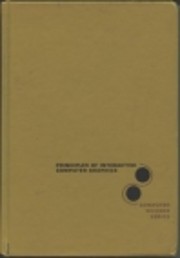

Klik op een omslag om naar Google Boeken te gaan.
|
Bezig met laden... Principles of Interactive Computer Graphicsdoor William M. Newman
 Geen Bezig met laden...
Meld je aan bij LibraryThing om erachter te komen of je dit boek goed zult vinden. Op dit moment geen Discussie gesprekken over dit boek. geen besprekingen | voeg een bespreking toe
Onderdeel van de reeks(en)
Covers Many Facets of Computer Graphics & Software Design, Including: Interactive Graphics, Point Plotting & Line Drawing Geen bibliotheekbeschrijvingen gevonden. |
Actuele discussiesGeenPopulaire omslagen
 Google Books — Bezig met laden... Google Books — Bezig met laden...GenresDewey Decimale Classificatie (DDC)001.55Information Computing and Information Knowledge [formerly : Cybernetics & related disciplines] [formerly : Information & communication] [formerly : Communication through records]LC-classificatieWaarderingGemiddelde: (4) (4)
Ben jij dit?Word een LibraryThing Auteur. |
||||||||||||||||||||||||||||||||||||||||||||||||||||||||||||||||||||||||||||||||||||||||||||||||||||||||||||||||||||||||
Der er lidt kuk i indholdsfortegnelse og indhold. Fx mangler 27-3 begge steder, men skulle nok være '27.3 A Transformed Display File Model'. 26.2 hedder 27.2 begge steder. (